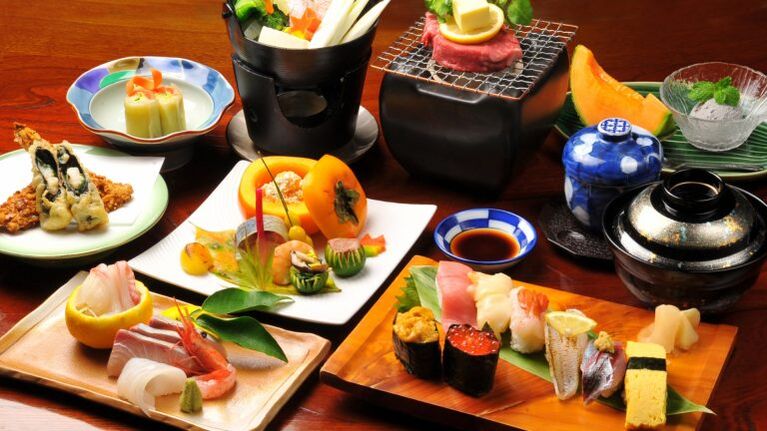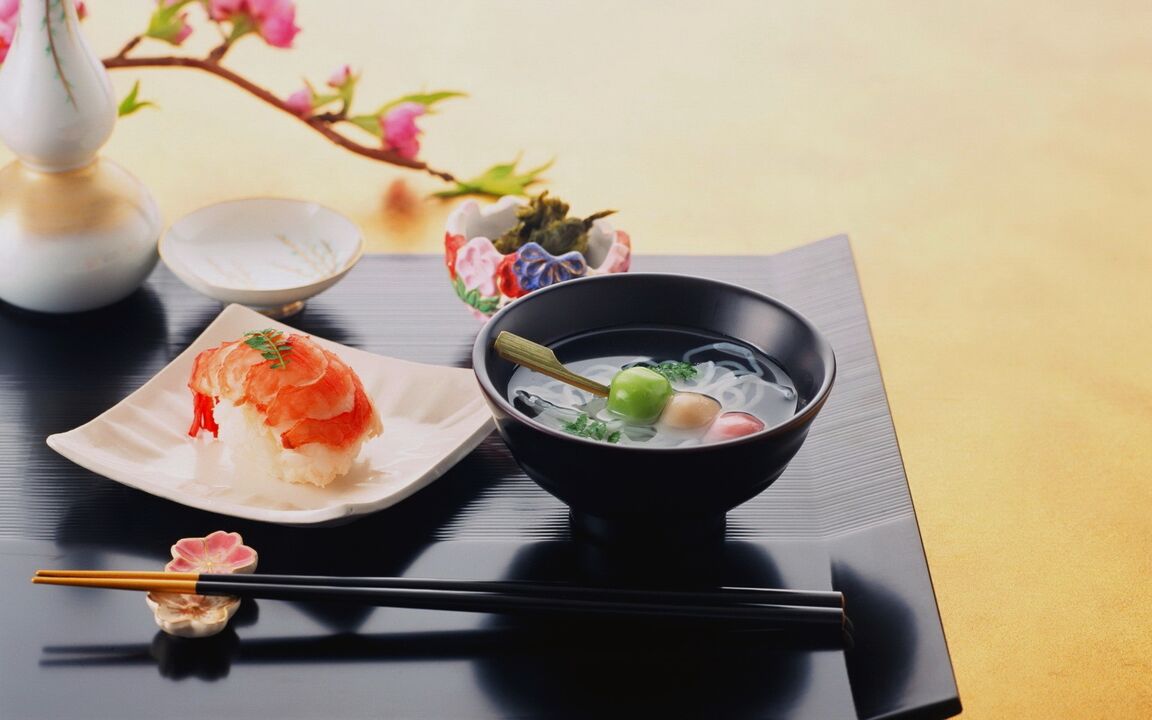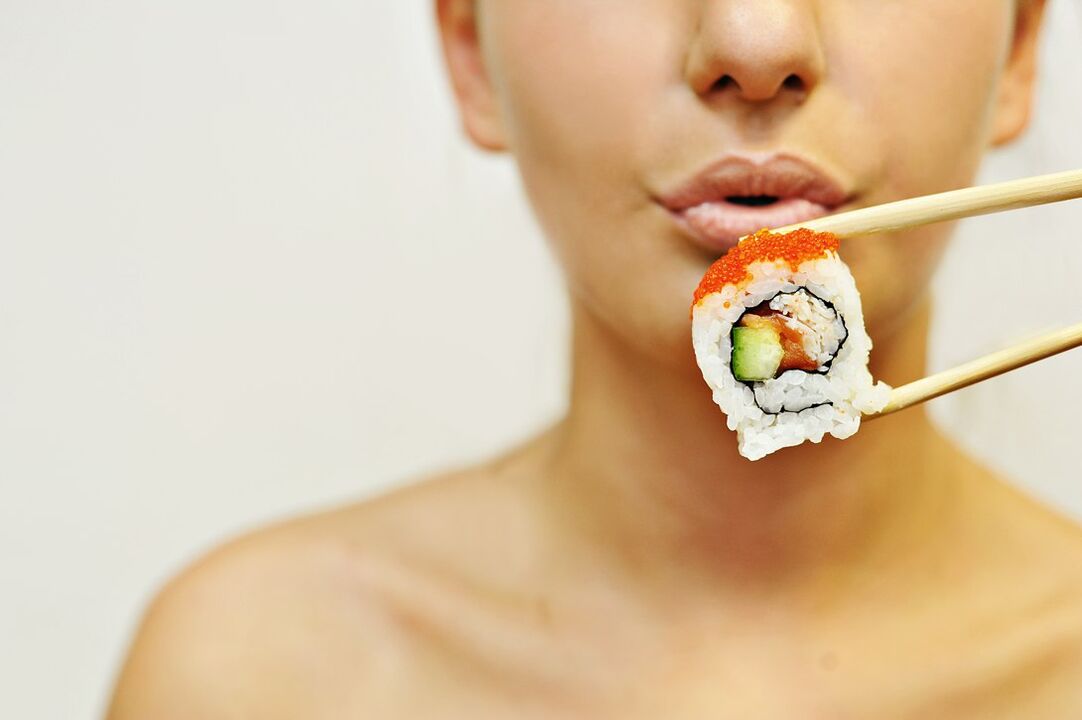In recent years, the Japanese diet has gained immense popularity, combining both rapid results and benefits for the body. What’s more, the main feature of this 2-week meal plan is that it doesn’t include a so-called rollback when everything returns to its original wheelbase after 2-3 weeks.
Japanese food is becoming more popular due to the growing popularity of Japanese cuisine in domestic cafes and restaurants. Today, you can buy buns or anything you need to make them in almost every cooking. So what is the Japanese diet for weight loss?

The main features of the Japanese diet for 14 days
Let's take a quick look at what Japanese dieting is and what its principles are:
- The total duration is 14 days;
- Low Carb, Low Carb, High Protein Foods. It requires discipline and perseverance;
- Total cost - no more than 2000 rubles for the full cycle;
- The estimated result is 5-8 kg;
- Repeatability - up to twice a year;
- Stability - high, with correct withdrawal from the diet after two weeks, the result is maintained for a long time and without restoration;
- Contraindications: pregnancy, lactation, gastrointestinal diseases (ulcers, gastritis, gastroduodenitis, etc. ), kidney and liver diseases. Not recommended for heart problems either. You should consult before starting your diet
Japanese Diet for Weight Loss - Trendy Trend or Real Effectiveness?

The Japanese diet was completely unknown before. Moreover, the concept of "diet" itself included a severe reduction in food and calorie intake, all the way to starvation. Even with the promotion of this unique diet plan, many believe that the Japanese diet consists of sushi, green tea and, of course, rice for 14 days. However, this diet should not be judged solely on traditional Japanese cuisine, only sea fish, eggs and green tea will remind you for two weeks - products found in many countries around the world. contains foods without any exotics that can lead to indigestion and even allergies.
It is not yet known exactly how the Japanese 14-day diet relates to the country of the Rising Sun. Some reportedly developed it at one Japanese clinic, others said it was attributed to Japan due to strict discipline, menu and efficiency. However, what matters is not where this diet comes from, but that it is incredibly effective and harmless when properly treated and adhered to.
As in any other case, the Japanese menu means you need to reduce your calorie intake in your diet. It is based on traditional Japanese cuisine, famous for its lack of fatty foods, plenty of vegetables and fish. One of the famous public figures and nutritionists, Naomi Moriyama, believes that nutrition is the secret of Japanese women who retain their beauty and slim figure until old age. He says the key is low carbs and low doses.
Naomi calculates that Japanese consume 25% fewer calories than those in any other country. For example, due to the abundance of various snacks and even so-called fast food, chips, chocolate slices, fatty sweets and not even butter are not particularly popular in Japan. Even "street food" is low in calories and low in fat and carbohydrates. Therefore, the Japanese diet menu is fully in line with the country’s food culture, traditions and dietary basics.
A proper diet is essential for burning fat! But think about what kind of result you want to achieve in the end? Are you sure that after getting rid of the fat layer, you will see a toned and strong body? Proper training is needed to increase muscle tone and increase sexual volume! And to make it easier, we recommend a ready-made workout plan diagram!
The concept and main rules of the Japanese diet

The portion sizes of residents of the CIS and Japan are significantly different, so for many, a sharp transition can be a real test. But don’t despair, because this plan is for two weeks, after which you can slowly return to your usual diet and favorite foods.
Protein will be the basis of your diet and a source of satiety. You can only get it from the following products:
- A fish;
- Egg;
- Chicken breast;
- Dairy products;
- Lean beef.
Only biscuits and several kinds of vegetables go carb. For fats - olive oil. In addition, fish and other protein products contain fats to avoid deficiency. The menu and regimen of a Japanese 14-day diet with significant restrictions on calories, especially carbohydrates, can be a real challenge. Nevertheless, it is worth noting that the body will quickly get used to such a diet, and the second week will not be so difficult.
It is important to note that healthy fiber is present in sufficient amounts on the menu. It is found in vegetables and can be consumed almost indefinitely (only on certain days). This eliminates gastrointestinal problems and improves digestion. Green tea and coffee are also included in the diet. Not only do they allow alertness and avoid fatigue, but they also provide the body with large amounts of antioxidants. It is important that the tea is natural, without dyes and flavors, and it is advisable to buy coffee beans and grind them by hand.
Reviewing the 14-day menu of the Japanese diet, you can be sure that all of the beneficial ingredients are included in this diet plan, with the main changes primarily affecting the size of the portions and the amount of food consumed. Basically, two weeks pass without any consequences for most people, but if your body has reacted too harshly to lowering your carbs, postpone your diet until the next day and see a doctor. The main symptoms of this are headache, severe weakness and tiredness.
The drinking system is of great importance. You should consume plenty of plain water at room temperature. First, it helps improve digestion and make it easier to cope with hunger by simulating a full stomach. Second, it allows the removal of protein processing products from the body. Another important point is strict adherence to the general plan. If you seriously decide to give it a try and look at how to lose weight with a Japanese diet, consume only the foods and amounts that are provided every day. Replacement is not allowed. You cannot change or rearrange the days.
The only exceptions are coffee and tea. In the morning, you can drink a cup of tea instead of coffee, depending on your personal preferences. Of course sugar free. Salt is also a negative factor in your diet, but if you can’t completely eliminate it, limit yourself to a minimum amount.
In addition to low calorie intake, one of the main difficulties is considered to be low meals a day. While other diets include 5 or even 8 snacks a day, the Japanese diet includes only 3 meals. It is also worth remembering that a glass of water should start the day, thus "starting" the body and metabolic processes. Dinner should be eaten no earlier than 2-3 hours to allow time for digestion.
This is a strict diet, so a smooth entry is recommended, excluding cutting transitions in the diet. This will allow the body to adapt quickly to the new conditions and make the diet more comfortable. The easiest way to prepare it would be to stop fast-food meals completely at least 3-5 days before you start losing weight and to cut the portions (do not eat at half the usual portion). Although this regimen may seem too rigid, it is perfectly balanced and does not harm the body, yet it allows you to lose 5-8 kg in just 2 weeks.
Preparation period and food purchase

You will need:
- Coffee (ground or grain) - 1 packet;
- Natural green tea - 1 packet;
- chicken eggs - 20 pieces;
- lean beef (pulp) - 1 kg;
- Sea fish (fillet) - 2 kg;
- Chicken fillet - 1 kg;
- Extra virgin olive oil - 0, 5 l;
- carrots - 2-3 kg;
- white cabbage - 2 pieces of medium size;
- Eggplant or zucchini - 1 kg;
- Fruit (excluding grapes and bananas) - 1 kg;
- Kefir - 1 l;
- Tomato juice - 1 l;
- Lemon - 2 pcs.
In terms of principles and food lists, the Japanese diet is often compared to, and even confused with, the "chemical diet" —the diet plan developed in the United States. Its creator is Osama Hamdiy, whose diet is actively used to treat diabetes and obesity. The Japanese diet also applies the principle of sharply limiting carbohydrates and increasing protein intake, which changes the chemistry of metabolic processes in the body, triggering reaction chains that lead to a sudden loss of weight. However, there is a significant difference between these meal plans. The Osama Hamdiya System includes an unlimited number of products that allow you to count on muscle building and intense training. However, the Japanese system has strict quantitative restrictions and a short period of only two weeks. This is a plus for those who want to get quick results and can’t exhaust their bodies for months, avoiding a normal diet.
A detailed menu of the Japanese diet for every day

It is important that this system is taken very seriously, with strict adherence to the recommendations. Attempts to interrupt the scheme or add products may result in worse-than-expected overall results. The daily menu for the Japanese diet for 14 days is as follows:
One day
- Breakfast - pure coffee without milk and sugar;
- Lunch - boiled eggs (2 pieces), boiled cabbage with olive oil, 1 glass of tomato juice;
- Dinner - 200 g of fried or cooked fish.
2 days
- Breakfast - Coffee and 1 slice of rye bread;
- Lunch - 200 g of fried or cooked fish with boiled cabbage and olive oil;
- Dinner - 100 g of boiled beef and 1 glass of kefir.
3 days
- Breakfast - a slice of rye bread (dried in a toast) or biscuits without additives. A cup of coffee;
- Lunch - fry eggplant or zucchini in olive oil (any portion size);
- Dinner - boil 200 g of beef without salt, fresh cabbage with olive oil, 2 boiled eggs.
4 days
- Breakfast - a fresh little carrot with a lemon juice;
- Lunch - 200 g of fried or cooked fish, 1 glass of tomato juice;
- Dinner - 200 g of fruit (any).
5 days
- Breakfast - a medium carrot with a whole lemon juice;
- Lunch - cooked or steamed fish with a glass of tomato juice;
- Dinner - 200 grams of fruit (any).
6 days
- Breakfast - a cup of coffee without sugar;
- Lunch - boiled chicken without salt (500 g), fresh carrot and cabbage salad (seasoned with olive oil);
- Dinner - a fresh carrot and 2 boiled eggs.
7 days
- Breakfast - a cup of green tea;
- Lunch - cooked beef without salt (200 g);
- Dinner - as desired: 200 g of fruit, 200 g of boiled beef with a glass of kefir, 200 g of boiled fish or 2 boiled egg salad (carrots sprinkled with olive oil.
8 days
- Breakfast - a cup of coffee;
- Lunch - 500 g of cooked chicken without salt, cabbage and carrot salad (seasoned with olive oil);
- Dinner - a little carrot with olive oil, 2 boiled eggs.
Day 9
- Breakfast - a carrot with a whole lemon juice;
- Lunch - 200 g of fried or cooked fish and a glass of tomato juice;
- Dinner - 200 g of selected fruit.
10 days
- Breakfast - a cup of coffee;
- Lunch - 3 small carrots (fry in vegetable oil), 1 egg and 50 g of cheese;
- Dinner - 200 g of any fruit.
Day 11
- Breakfast - a cup of coffee and 1 slice of rye bread;
- Lunch - fry eggplant or zucchini in olive oil (in any quantity);
- Dinner - 200 g of boiled beef, fresh cabbage with olive oil, 2 boiled eggs.
Day 12
- Breakfast - a cup of coffee and a slice of rye bread;
- Lunch - 200 g of fried or cooked fish with fresh cabbage in olive oil;
- Dinner - 100 g of boiled beef and 1 glass of kefir.
Day 13
- Breakfast - a cup of coffee;
- Lunch - 2 boiled eggs, boiled cabbage with olive oil and 1 glass of tomato juice;
- Dinner - fry 200 g of fish in olive oil.
Day 14
- Breakfast - a cup of coffee;
- Lunch - fried or cooked fish with fresh cabbage in olive oil;
- Dinner - 200 grams of boiled beef, 1 glass of kefir.
There is an opinion that this diet allows you to achieve the longest lasting results without returning to normal weight. After losing weight, you can maintain your weight for up to 3 years, but only on the condition that you strictly follow your diet and don’t start compensating for everything with high-calorie foods right after day 15. It’s also a great solution to adjust your Japanese meal plan to your daily diet.















































